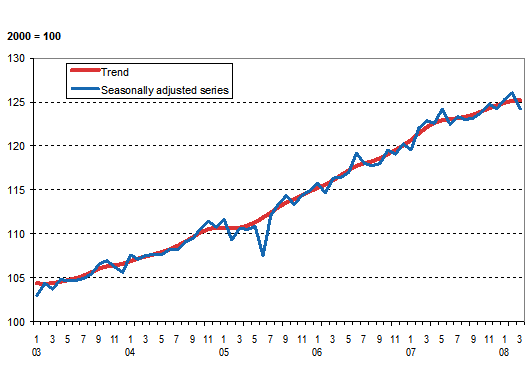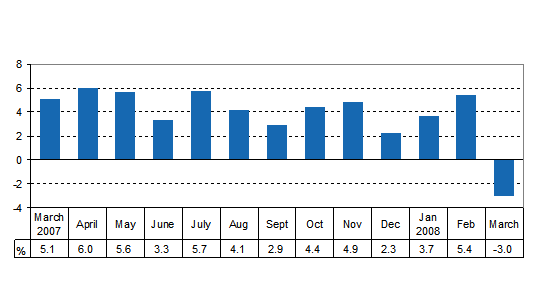Published: 15 May 2008
Output of the national economy fell in March
Seasonally adjusted output fell by 1.5 per cent in March from the month before. Year-on-year, the decline amounted to 3.0 per cent. March 2008 had three fewer working days than March of the year before. Adjusted for working days, there was 1.0 per cent growth year-on-year. The data derive from Statistics Finland's Trend Indicator of Output.
Volume of total output 2003 - 2008, trend and seasonally adjusted series

The series of the Trend Indicator of Output are seasonally adjusted with the Tramo/Seats method. The latest observations of the series adjusted for seasonal and random variation (seasonally adjusted and trend series) become revised with new observations in seasonal adjustment methods.
Percentage changes of total output from the previous year's corresponding month

Secondary production is estimated to have fallen by good three per cent and services by just short of three per cent. However, adjusted for working days, secondary production grew by good two per cent and services remained on level with the previous year. Primary production declined by under eight per cent from its level in March of the year before, but by four per cent when adjusted for working days. Secondary production includes manufacturing and construction, services and trade, hotel and restaurant industries, transport and business activities as well as real estate, renting and research services, financial intermediation and insurance, and public services. Primary production refers to agriculture, forestry and fishery.
The former Monthly Indicator of Total Output is being revised
Starting from February publication, the statistics will be published as the Trend Indicator of Output. The calculation of the indicator has been harmonised with the calculation methods of quarterly accounts output, and the development work will continue in 2008. The calculation of industry-specific data is now based primarily on value data deflated according to the average prices of the year before. Thus volume figures at the previous year's prices are obtained, in which the previous year is always used as the base year. Using volume changes at the previous year's prices, a continuous volume series at year 2000 prices is chained according to the so-called annual overlap method. This series is published as the Trend Indicator of Output. This method corresponds to the deflation and chaining method applied to quarterly accounts output. In this publication the calculation of value data is based on 54 sources and the description of price developments on 55 sources. The time series have been completely revised as from 1996 according to the new sources and methods.
The volume of source data used in the calculation of the Trend Indicator of Output has been increased significantly and the calculation is performed at a more detailed level than before (2-digit level of the Standard Industrial Classification). The publication level is primary production, secondary production and services. In the published indicator a considerable part of the source data used in the calculations has been revised according to the revised quarterly accounts. As regards manufacturing and private services, the source data used are primarily the preliminary data of the indices of turnover. Development work continues for the other industries.
Source: Trend Indicator of Output 2008, March. Statistics Finland
Inquiries: Mr Veli-Pekka Karvinen +358 9 1734 2667, Mr Samu Hakala +358 9 1734 3756 kansantalous.suhdanteet@stat.fi
Director in charge: Mr Ari Tyrkkö
- Tables
-
Tables in databases
Pick the data you need into tables, view the data as graphs, or download the data for your use.
Last updated 15.5.2008
Official Statistics of Finland (OSF):
Trend Indicator of Output [e-publication].
ISSN=1798-5439. March 2008. Helsinki: Statistics Finland [referred: 13.12.2025].
Access method: http://stat.fi/til/ktkk/2008/03/ktkk_2008_03_2008-05-15_tie_001_en.html

